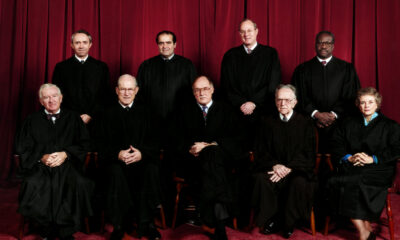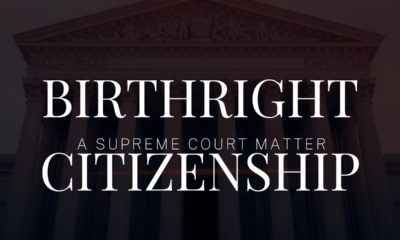Executive
John Quincy Adams and Abraham Lincoln
Abraham Lincoln must have taken inspiration from former President – and fellow Congressman – John Quincy Adams in his fight against slavery.
Today, of course, is June 19, 2023 – Juneteenth. Specifically it is the anniversary of word reaching Galveston, Texas of the Emancipation Proclamation. That Proclamation did not end the War Between the States; Lt. Gen. Ulysses S. Grant did that at Appomattox. Nor did it end slavery once and for all; for that, President Abraham Lincoln campaigned to amend the Constitution itself. But it was a good start toward both ends. Still, few people remember where Abraham Lincoln drew much of his inspiration. He got it from a former President who died in his presence fifteen years before: John Quincy Adams.
John Quincy Adams, heritage and Presidency
John Quincy Adams was, of course, born into one of America’s most famous families. His father argued strenuously for American independence in the Second Continental Congress, and represented America in Europe – and eventually in England. When the Articles of Confederation failed, the elder Adams was elected Vice-President under the new Constitution. He of course served one term as President, during which he kept America out of a war in Europe and stopped what could have developed into a military coup against him. His actions weren’t popular – they cost him a second term as President – but they were critical. But they also overshadow another argument he tried to make: to take a stand against slavery.
John Adams made little headway against the institution, but his son John Quincy Adams took up the cause in turn. His most remarkable action against slavery happened after he left the Presidency. After losing reelection in 1828, he ran for Congress in 1830 and won. He would serve in Congress for seventeen years, before his death.
In 1837, he reflected on his career, and was disappointed. In his negotiations with Spain, he had secured enough territory to ensure American security against any European power. But as long as slavery remained, he considered that he had failed. But he would not accept failure. Beginning then, he would fight.
Two great fights
John Quincy Adams ended up fighting on two fronts. The House of Representatives had made a rule – the Gag Rule – forbidding any discussion of slavery. That, Adams realized, was a concession to Southern Members – and Southerners in those days had a peculiar sense of honor. As Richard Samuelson observed last year in The Washington Examiner, a Southerner might hold himself within his rights to settle a political quarrel in a violent manner. But even a Southerner would not dare do that to a former President (and son of a President). So when Adams called them out, they had to take it.
So Adams set about chipping away at the Gag Rule, until several Southerners brought a resolution of censure against him. That resolution failed. By 1844, the Gag Rule failed, too.
Most Americans remember much better when John Quincy Adams took up the defense of the Amistad mutineers. The Amistad’s officers had taken on a “cargo” of 52 slaves newly captured in Africa. They made a mutiny, killed the captain and most of the crew, and ordered two survivors to take them back to Africa. Instead the two Spaniards brought the vessel into American waters, where an American ship captured her.
Adams took up the mutineer’s defense. One can read here his argument for their freedom before the Supreme Court. On March 9, 1841, the Court agreed with Adams. (U.S. v. Amistad, 40 U.S. (15 Pet.) 518, 1841.)
A fateful meeting
Such was the history of the former President, now Congressman, when a young lawyer from Illinois first met him. For three months they served together in the House. The man from Illinois had his own reasons to oppose slavery. He once witnessed a slave auction, and the spectacle of human beings buying and selling other human beings sickened him. As Dale Carnegie would eventually write, he formed a resolution to “hit” the institution “hard.”
So this young man must have learned the reputation of John Quincy Adams. Memories of the Gag Rule fight and the failed censure resolution would still have been fresh. The Amistad case likely made a deeper impression, especially to a young lawyer. No one knows definitively; records from the Massachusetts Historical Society and the Lincoln Library are silent on this point. Except for one thing: Rep. Abraham Lincoln of Illinois did serve on the Committee on Arrangements, which had a mission to publish the collected speeches of John Quincy Adams after his death. (Adams literally collapsed on the floor of the House and died two days later.) Those speeches cannot have failed to impress Lincoln.
Thirteen years after Adam’s death, Abraham Lincoln took command of an already divided country. In the years following, by proclamation and definitely by changing the Constitution, he succeeded where John Quincy Adams had failed.
Terry A. Hurlbut has been a student of politics, philosophy, and science for more than 35 years. He is a graduate of Yale College and has served as a physician-level laboratory administrator in a 250-bed community hospital. He also is a serious student of the Bible, is conversant in its two primary original languages, and has followed the creation-science movement closely since 1993.
-

 Civilization1 day ago
Civilization1 day agoDC Pipe Bomb Arrest Raises Questions About Christopher’s Wray’s FBI
-

 Executive4 days ago
Executive4 days agoThe Last Supper: New York’s Socialist Feast
-

 Civilization4 days ago
Civilization4 days agoYoo Hoo, VP Vance—Your Character is Showing!
-

 Guest Columns3 days ago
Guest Columns3 days agoCongressional Leaders See Far Higher Stock Returns Than Peers
-

 Civilization2 days ago
Civilization2 days agoThe Legal Logic Behind U.S. Operations Against Narco-Terrorist Networks
-

 Civilization4 days ago
Civilization4 days agoFacing Facts & Rolling Back Mythologies: The New National Security Strategy
-

 Civilization3 days ago
Civilization3 days agoHow Trump Changed America
-

 Civilization5 days ago
Civilization5 days agoWaste of the Day: Senators Earmarked Cash for Their Former Schools













